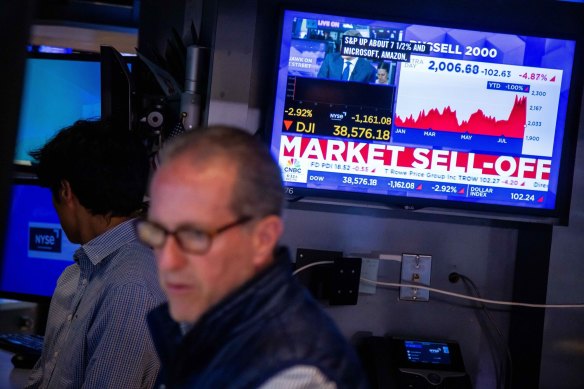This was published 6 months ago
Opinion
Was the flash crash a false alarm or a sign of worse to come?
Stephen Bartholomeusz
Senior business columnistAn uneasy calm has returned to financial markets after the past few turbulent days.
Wall Street was up about 1 per cent on Tuesday, while Japan’s market, smashed on Monday when it plunged 12 per cent, had its best day since 2008 as it rebounded by nearly 10 per cent. Bond yields edged back up and volatility, which spiked alarmingly on Monday, subsided.
So what just happened – and what is likely to happen next?

It was a black day on Wall Street on Monday. What just happened?Credit: Bloomberg
The backdrop to the global sell-off that began on Friday and accelerated dramatically on Monday was provided by markets that had been surprisingly optimistic, given some of the vulnerabilities within the global economy.
The US sharemarket, buoyed by the excitement around artificial intelligence that had boosted the prices of the technology mega-stocks, was trading near record highs, even as some unease about the economics of AI were starting to emerge.
Equity and bond investors were increasingly confident that the long-awaited cuts to US interest rates would begin in September.
In Japan, with the Bank of Japan just about to start raising rates and reducing its bond-buying, the yen began to strengthen, triggering an unwinding of the massive carry trades in which hedge funds and others borrowed cheaply in Japan to invest in higher-yielding assets – currencies, bonds, US tech stocks and other risk assets – elsewhere.
An unexpectedly weak US jobs report, which raised fears of a recession in the world’s largest economy, hit at just the right moment to puncture the AI-inflated bubble in tech stocks and prompt a rush for the exits from the multitrillion-dollar yen-based carry trades.
In today’s financial markets, there is a proliferation of complex and quite exotic trading strategies. There are various arbitrage strategies using options or other derivatives, whether over securities or indices. There are structured products. There is a lot of algorithmic and automated trading. There are a lot of powerful, but passive, index funds and a variety of exchange-traded funds, some pursuing exotic strategies of their own. There is also a lot of leverage.
Those strategies tend to be self-reinforcing, helping to boost the markets when they are calm, but greatly exacerbating the extent of any material sell-off as margin calls hit or risky trades need to be closed out.
That could explain why a reasonably orderly trading day on Friday after the weak US jobs data turned into a panicked rout on Monday.
It might also explain why the impact in Japan, the major funding source for a range of carry trades, was so much greater than in America, where the economic implications of the jobs report might have been expected to have had a more obvious impact. The US market was down “only” 3 per cent on Monday, compared with the Nikkei’s 12 per cent plunge.
If we step back from the market gyrations, it is clear that there are reasons for investors to regard the jobs data, albeit covering just a single month, as a warning to reduce risk and for sharemarkets to retreat from levels that would seem inconsistent with the real economy’s performance.
The US economy, while still growing, is slowing, and the Federal Reserve Board has been too slow to respond, although it can play catch-up at next month’s meeting and start cutting interest rates.
The world’s largest economy and its interest rates have global influence – but it’s not just the US economy that is faltering.
The other big global growth engine, China, also has significant challenges, and the eurozone is posting only meagre growth.
In Japan, the combination of rising interest rates, the withdrawal of central bank liquidity and a stronger yen as the Bank of Japan tried to finesse a sustainable inflation rate should continue to weaken growth, while also continuing to close out the carry trades.
Commodity markets have arguably reflected the gloomier outlook better than the equity or bond markets.
The copper price is particularly sensitive to economic conditions. It was trading at record levels in May but had fallen by more than 18 per cent by the start of this month. It has shed another 4 per cent in the past few days.
Oil, highly leveraged to the relationship between demand and supply, is another commodity that provides an insight into what’s occurring within real economies. In April, it was trading above $US90 a barrel, but had edged down to just above $US80 a barrel by the end of July, and is now priced about $US76 a barrel.
Iron ore prices have tailed away as the year has progressed because of the relatively weak growth in China as domestic demand has dried up.
Trading in those commodities, and others, like gold, which has lost more than $US30 an ounce since last Friday, may have been affected by the broader market turmoil. Sales of gold or other commodities over the past few days may have been a source of liquidity to meet margin calls.
Nevertheless, the developing trends throughout this year do highlight the broader fragility within the global economy and within the US and Chinese economies in particular.
There was, for instance, a discernible downward lurch in the copper price in the middle of last month when China’s Third Plenum of the Communist Party’s leadership failed to produce any major or detailed policy initiatives.

Clouds on the horizon: Donald Trump’s trade, tax and immigration policies would damage both of the world’s two biggest economies.Credit: Bloomberg
Increasing resistance to its exports-dependent growth strategy is another cloud over its outlook – and America’s – if Donald Trump were to regain the White House and implement his draconian trade strategies, which include a 60 per cent tariff on China’s exports to the US and a 10 per cent baseline tariff on all other imports.
Trump’s trade, tax and immigration policies would be highly inflationary and damage both of the world’s two biggest economies.
Therefore, while the vehemence of Monday’s sell-off may have shocked, a realignment of financial market valuations to better reflect real economic conditions and prospects shouldn’t have.
Markets are forward-looking and have been pricing in the positive impacts of the expected rate cuts by the Fed and other central banks – the Fed is now expected to cut US rates at least three times and by more than 1 percentage point before the end of the year. But it is improbable that US or global economic conditions will improve dramatically enough over the next year or so to have validated the near-record sharemarket levels that prevailed until Friday.
In the longer term, maybe the impact of AI will be so radical and transformative that it will rationalise the valuations investors have been prepared to put on the mega-techs. In the near term, however, there will be hundreds of billions of dollars spent for modest, if any, returns.
Aftershocks driven by the extent and pace of what occurred within markets can’t be ruled out, and the past few days may have been unnerving. But blowing some of the froth off overly optimistic valuations might better reflect real economy conditions and prospects, and provide a sounder base for markets – and a less volatile one for investors – going forward.
The Market Recap newsletter is a wrap of the day’s trading. Get it each weekday afternoon.